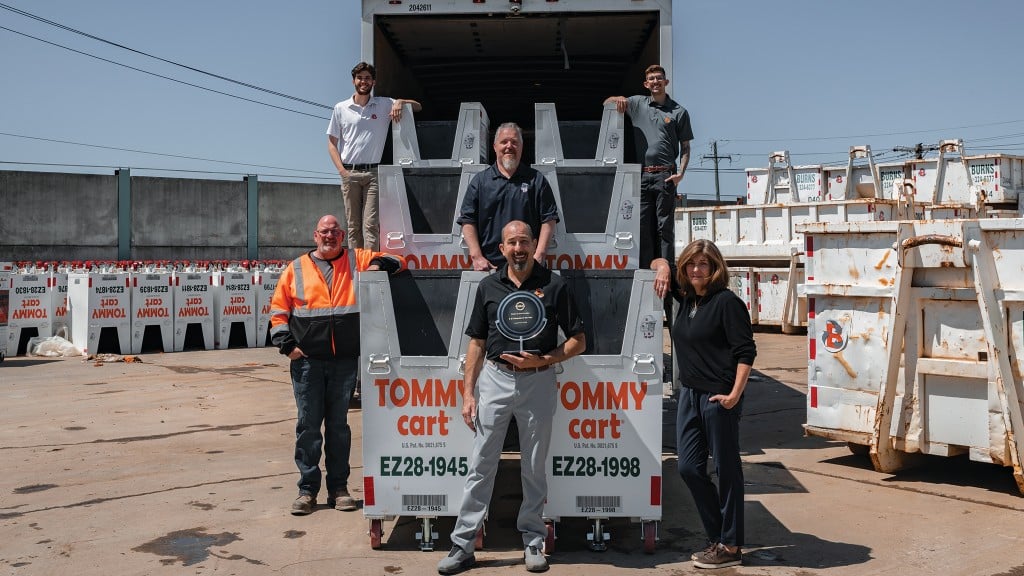The EWI Reverse Polymerization (RP) process, when applied to scrap tires, reduces them to their base components (carbon black, steel, hydrocarbon gases and oil). The system directly applies microwave energy to the tires as they pass through a nitrogen filled tunnel on a continuous basis. The nitrogen prevents the formation of hazardous by-products, such as dioxins and furans, that can form when oxygen is present. The RP process allows for a high level of processing control through its proprietary Microwave Delivery System, which guides and monitors the microwave energy produced. Plus, each magnetron is individually controlled, allowing the system to continuously adjust the amount of energy being applied in any section of the tunnel.
The carbon black produced is of high enough quality to be used in new rubber production or other feedstock, and steel is ready for sale to recyclers. From a 20-pound (9.1 kg) tire, seven pounds (3.18 kg) of carbon black and two pounds (0.91 kg) of steel are recovered. The remainder of the tire (oil and hydrocarbon gases) can be reused in the production of electricity or sold for use in other applications. The process yields almost 100 percent reuse and recycling of the scrap tire feed.
This tire reduction system is designed around EWI’s TR-1500 as the base module. The TR-1500 processes 1,500 tires per day (500,000 annually), and when combined as four modules, as the model TR-6000, will process 6,000 tires daily (2,000,000 annually). In a year, the TR-6000 reclaims about 22.5 tons (20.5 tonnes) of carbon black, six tons (5.5 tonnes) of steel, and over 1.6 million gallons of oil. The remaining hydrocarbon gases can be used to produce power needed to operate the system. Alternatively, the oil and gas can be combined to produce up to six MW of power, netting almost three MW for use by local industries or homes.
When compared to utilizing tires as a tire derived fuel (TDF), the mass savings gained with the EWI system is equivalent to 27,500 tons (25,000 tonnes) of CO2 per year. There is a further decrease in carbon emissions as the use of recycled carbon black reduces the need for production of new material, which is an emission-intensive process. In addition, the hydrocarbons produced from the Reverse Polymerization process are much lower in sulfur than the scrap tire rubber; therefore, there is a significant reduction (88 percent) in the sulfur released to the atmosphere by generating power from Reverse Polymerization, compared to the burning of tire derived fuel.
The carbon black produced is of high enough quality to be used in new rubber production or other feedstock, and steel is ready for sale to recyclers. From a 20-pound (9.1 kg) tire, seven pounds (3.18 kg) of carbon black and two pounds (0.91 kg) of steel are recovered. The remainder of the tire (oil and hydrocarbon gases) can be reused in the production of electricity or sold for use in other applications. The process yields almost 100 percent reuse and recycling of the scrap tire feed.
This tire reduction system is designed around EWI’s TR-1500 as the base module. The TR-1500 processes 1,500 tires per day (500,000 annually), and when combined as four modules, as the model TR-6000, will process 6,000 tires daily (2,000,000 annually). In a year, the TR-6000 reclaims about 22.5 tons (20.5 tonnes) of carbon black, six tons (5.5 tonnes) of steel, and over 1.6 million gallons of oil. The remaining hydrocarbon gases can be used to produce power needed to operate the system. Alternatively, the oil and gas can be combined to produce up to six MW of power, netting almost three MW for use by local industries or homes.
When compared to utilizing tires as a tire derived fuel (TDF), the mass savings gained with the EWI system is equivalent to 27,500 tons (25,000 tonnes) of CO2 per year. There is a further decrease in carbon emissions as the use of recycled carbon black reduces the need for production of new material, which is an emission-intensive process. In addition, the hydrocarbons produced from the Reverse Polymerization process are much lower in sulfur than the scrap tire rubber; therefore, there is a significant reduction (88 percent) in the sulfur released to the atmosphere by generating power from Reverse Polymerization, compared to the burning of tire derived fuel.


